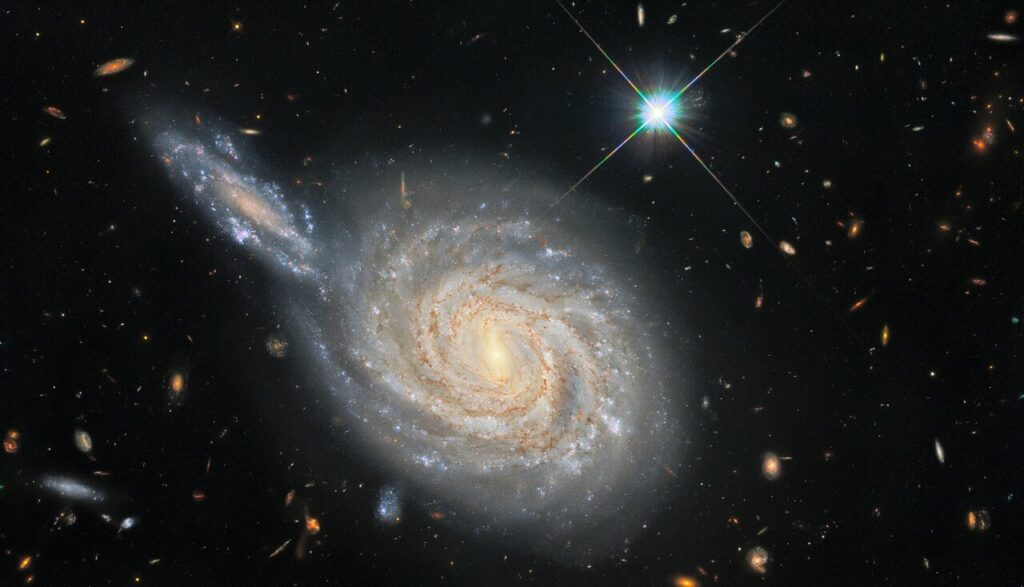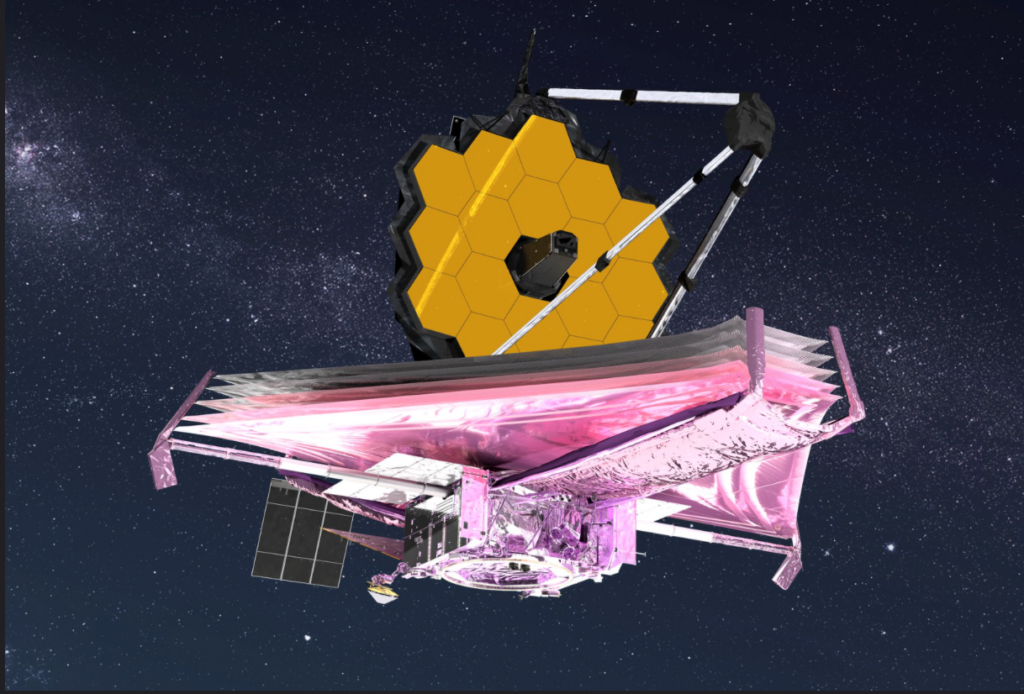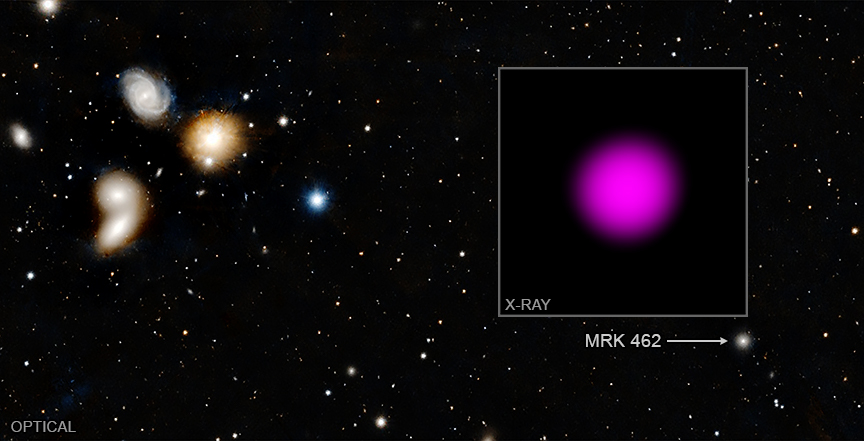China’s Chang’e-5 lunar lander has made the first in situ detection of water on the Moon, using reflectance spectroscopy from the surface of our natural satellite. Plus, all the news from the AAS virtual press conferences, including black holes and galaxies.
Podcast
Show Notes
The Gaia-Sausage-Enceledus galaxy delivered halo stars
- CFA Harvard | Smithsonian press release
- “Reconstructing the Last Major Merger of the Milky Way with the H3 Survey,” Rohan P. Naidu et al., 2021 December 14, The Astrophysical Journal
Double Distance Indicators lead to new issues
- NASA Goddard press release
JWST now looks like a telescope
- NASA press release
MSU postdoc pioneers new black hole detection technique
- MSU press release
- “A Sample of Massive Black Holes in Dwarf Galaxies Detected via [Fe x] Coronal Line Emission: Active Galactic Nuclei and/or Tidal Disruption Events,” Mallory Molina et al., 2021 November 26, The Astrophysical Journal
Supermassive black hole found in dwarf galaxy
Black hole left mess when eating decades ago
- Caltech press release
- “FIRST J153350.8+272729: the radio afterglow of a decades-old tidal disruption event,” Vikram Ravi et al., submitted to The Astrophysical Journal (preprint on arxiv.org)
New class of supernova designated ‘cow’
- Caltech press release
- “The X-ray and Radio Loud Fast Blue Optical Transient AT2020mrf: Implications for an Emerging Class of Engine-Driven Massive Star Explosions,” Yuhan Yao et al., submitted to The Astrophysical Journal (preprint on arxiv.org)
Chinese lunar lander detects water on Moon
- China’s Chang’E-5 Lander Makes First Onsite Detection of Water on the Moon (SciTechDaily)
- “In situ detection of water on the Moon by the Chang’E-5 lander,” Honglei Lin et al., 2022 January 7, Science Advances
Transcript
Hello and welcome to the Daily Space. I am your host Dr. Pamela Gay.
And I am your host Beth Johnson.
And we are here to put science in your brain.
This week should have been the American Astronomical Society meeting, but the sudden growth of the omicron carient of COVID-19 led to the meeting’s cancellation, but not the cancellation of the press conferences and planned university press releases. This means that this week, we’re going to be bringing you a whole lot of stories on stars, galaxies, and all the amazing objects in between.

In our first story of the day, we bring you galaxy mergers close to home. In a new paper appearing in The Astrophysical Journal, researchers led by Rohan Nauidu combine data from the Gaia mission with follow-up ground-based observations from the MMT in Arizona to document the lineage of stars in the Milky Way’s outer halo.
Our galaxy, like most large galaxies, has formed through the mergers of smaller systems over time. We can see traces of the most recent mergers in streams of stars that all have the same composition and share orbits that echo back to the trajectory of their host system.
While these stellar streams are fascinating, each of them contributes only a small mass of stars, typically less than 1% of our galaxy’s mass. Hidden in and around all these streams, however, is a population of stars that merged with the Milky Way eight to ten billion years ago and brought with it roughly half the stars in the galactic halo. This diffuse spheroid of stars includes objects orbiting in all orientations, and in this new paper, researchers were able to work out that the object that merged with the galaxy came such that the motions of its objects run counter to the orbits of the stars already here.
You may have noticed I didn’t mention the name of that colliding galaxy. It’s the Gaia-Sausage-Enceledus dwarf galaxy. And yes, that is a ridiculous name. It is referred to in some places as the Sausage or Gaia Sausage galaxy because Gaia found that the remnant stars form a sausage shape with their orbits. Other places, it’s called the Gaia-Enceledus galaxy after Gaia and her Titan son in mythology. And for good measure, many folks just put all three words together for one ridiculously named result.
Folks, please stop letting astronomers name things. Please?
Certain stories can be counted on to come out the week of AAS. You can expect one or more stories on galaxies historically merging with the Milky Way, and you can expect updates on our understanding of how the universe is expanding. And this year’s updates are scientifically solid if you are an observer and deeply troubling if you are a theorist.

Researchers using the Hubble Space Telescope have observed a series of galaxies that contain both Cepheid variable stars we can see and have been home to Type Ia supernovae. These two kinds of objects are used to measure distances throughout our universe, and finding both kinds of objects together allows us to calibrate our measuring tools, so to speak.
Cepheids can be seen nearby and out to distances of a few hundred million light years. For the nearby ones, Gaia and other missions have measured the distances using parallax – a method based on simple triangulation that requires super accurate measurements.
Cepheids are fascinating stars that change in size and brightness over tens of days, and the periods of their repeating pulses are directly related to their luminosity. It is as if every 100-Watt bulb flashed every ten seconds, while every 40-Watt bulb flashed every 6.2 seconds. By measuring the rate of the pulses, we know how much light the stars give off, and by measuring how bright they appear, we can measure how far away they are.
Type Ia supernovae are exploding stars, and theoretically, all the stars are about the same mass and explode with the same energy, give or take some correction factors. This means that when we see the signature of a Type Ia supernova, we can measure the light of the explosion, and knowing its actual energy, calculate its distance.
Between Cepheids being used for everything within a few 100 million light-years and Type 1a supernovae being used for everything further away, we can measure a lot of the universe and how it is expanding. And in these newly published results, with their beautifully calibrated new data, they get a result that indicates the universe is expanding faster than theory and observations of the Cosmic Microwave Background say it should be. If true, this means there is something fundamentally wrong with our understanding of the details around the expansion of the universe.

The Hubble Space Telescope was launched with the primary goal of measuring the expansion rate of the universe. It turns out the best Hubble has been able to do so far is post an update stating, “It’s complicated.”
The JWST is now getting ready to enter the scene and add its own complications to our understanding of the universe, assuming it works, and until we have healthy data, we’re going to have that caveat. At this point, the obviously scary parts of its assembly are over, however, and the origami telescope has been unfolded to form a complete telescope. We are still watching to see if its actuators and other systems work, allowing it to focus and image, but it at least looks like a telescope.
While JWST continues to dominate the headlines for mainstream media with its potential for groundbreaking science, we here at Daily Space want to make sure that we don’t neglect the advances that come closer to home. Especially when those advances don’t have to be launched into space on complicated telescopes that are dead to us until they are collecting data.
We may have thoughts and feelings around here.
Anyway, back to Earth-based pioneers. In new research published in The Astrophysical Journal and presented during yesterday’s AAS press conferences, a postdoctoral researcher at Montana State University, Mallory Molina, has come up with a new way to find massive black holes in dwarf galaxies, all by changing the color of the flashlight beam. No, really.

It’s difficult to find black holes, especially in distant or smaller galaxies. The light we measure ends up being the total light from the galaxy, and it can be hard to break out just the light being emitted by the infalling stars, gas, and dust. And if that galaxy is still forming stars, then the process of detection is even more complicated. Molina explains the issue by using a flashlight as a stand-in for the light that is coming from a black hole: It would be easy enough to see the beam if the area is dark. But what if someone turns on a spotlight? The flashlight can’t compete with the larger light source. Is there a way to cut through star formation and find black holes in these galaxies?
And that’s where she decided to change the color of the flashlight beam.
Molina’s new method uses a wavelength of light that’s only 6,374 angstroms as a marker for the black holes. This light comes from isotopes of iron 10, which have no electrons and give off light that produces coronal emission lines. Using this technique, Molina found two black holes in dwarf galaxies previously only detected in radio wavelengths. That first detection means iron 10 is detectable this way, and the second detection proves you can use this method in a survey. And as Molina concludes: Almost all of the iron 10 emission that I detected was way too bright to be produced by stellar means like supernovae, but it was consistent with material falling onto a black hole.
We send our congratulations to Dr. Molina for her groundbreaking work.

Speaking of black holes and dwarf galaxies, a new image released by the Chandra X-ray Observatory and presented at an AAS press conference shows the detection of X-rays coming from dwarf galaxy Mrk 462. These X-rays reveal the existence of a supermassive black hole, about 200,000 times the mass of the Sun, hiding within the dwarf galaxy, which only contains several hundred million stars compared to the hundreds of billions of stars in our own Milky Way galaxy.
As mentioned in our previous story, finding black holes in dwarf galaxies is difficult, and this is one of the few times we have managed to detect one. Instead of using spectral lines, Chandra looks for X-rays, which are emitted when gas is superheated and glows brightly as it falls in toward the black hole. And Chandra looked at eight dwarf galaxies in this recent study; Mrk 462 was the only one that had the X-ray signatures of a black hole. Co-author Ryan Hickox notes: Because buried black holes are even harder to detect than exposed ones, finding this example might mean there are a lot more dwarf galaxies out there with similar black holes. This is important because it could help address a major question in astrophysics: How did black holes get so big so early in the universe?
Black holes have been found that are a billion times the mass of the Sun and existed when the universe wasn’t even a billion years old. One school of thought was that massive stars collapsed early on and formed black holes that were about 100 solar masses, and then those black holes somehow grew really quickly. Another possibility is that there were many black holes around tens of thousands of solar masses all over the universe created when huge clouds of gas and dust collapsed.
As we get a better understanding of what fraction of dwarf galaxies have supermassive black holes, we should be able to pick one of those two options as the correct one. As the press release states: A large fraction of dwarf galaxies with supermassive black holes favors the idea that small black hole seeds from the earliest generation of stars grew astonishingly quickly to form the billion solar mass objects in the early universe. A smaller fraction would tip the scales to favor the idea that black holes began life weighing tens of thousands of Suns.
However, one sample is not enough to determine any sort of conclusion. Here’s hoping we can use Dr. Molina’s new technique to get us closer to an answer.

Black holes are the mess makers of the universe. From spewing out jets as we talked about last week to belching X-ray bubbles and blasting apart star formation, they are basically monsters that come in all sizes. And now, thanks to a wealth of archival data, one messily-eating black hole has been identified. By comparing radio observations taken over decades, high school interns uncovered a galaxy that was brighter in the mid-1990s than it is today. Brighter by a lot.
Further examination of the data over the past several years has revealed the story of a star passing too close to a black hole and getting torn apart – spaghettified – under the force of its gravity. This event shone brightly in the radio and was captured by the Very Large Array. Digging through even older data from the 1980s revealed that the object, blandly designated J1533+2727, was 500 times brighter in the mid-1980s than it is today.
According to study lead author Vikram Ravi: This is the first discovery of a relativistic Tidal Disruption Event (TDE) candidate in the relatively nearby universe, showing that these radio-bright [events] may be more common than we thought before.
Collaborator Jean Somalwar adds: TDEs basically turn flashlights onto these extreme regions at the centers of galaxies that we would not otherwise be able to see.
This work appears in The Astrophysical Journal.
Put another way, a black hole ate a star that flared out a massive amount of light before falling into the black hole’s event horizon, and that light lit up rarely seen regions of another galaxy. If only other messy eaters were so scientifically useful.
Folks, listen to Beth when she says you shouldn’t let astronomers name things. We do terrible terrible things.

For instance, in 2018 a star exploded, and a predetermined way to name things meant that glorious object was named AT2018cow, and c-o-w spells ‘cow’, and now, I kid you not, since that particular exploding star was the first of a newly identified type of exploding star, these supernovae are called Cow supernovae.
Astronomers can do many things well. Naming is not one of them.
What makes Cows unique is their short-lived brightness. These stellar explosions are ten times brigher than typical supernovae, fad much more quickly, and also flicker in X-rays. Early analysis hinted these events may be massive stars transitioning into black holes or neutron stars in their deaths.
Now, a total of five objects have been found, with the latest event, AT2020mrf, being published in a new paper in The Astrophysical Journal with first author Yuhan Yao. This latest event is also the brightest to date, and Yao explains: The large amount of energy released and the fast X-ray variability seen in AT2020mrf provide strong evidence that the nature of the central engine is either a very active black hole or a rapidly spinning neutron star called a magnetar. In Cow-like events, we still don’t know why the central engine is so active, but it probably has something to do with the type of the progenitor star being different from normal explosions.”
The more we look up, the more weird and rare things we have the chance to find, and these terribly named objects are my new favorite things to watch the research on.

China is in the middle of an ambitious four-phase lunar exploration program, and the most recently completed step included the landing of Chang’e 5, whose purpose was to take and return a sample of the lunar surface. The lander arrived on the Moon on December 1, 2020, collected over 1,700 grams of lunar rock and regolith, and returned to Earth on December 16, 2020. This accomplishment made China only the third country to bring back samples of the Moon, after the U.S. and Soviet Union, and the first to do so in almost 45 years. But sample collection wasn’t the only science performed by the lander.
Chang’e 5 landed in a geologically young mare basalt, basically a lava flood plain, and took spectral reflectance measurements of the surrounding rock and regolith. With a correction made to account for the heat of the lunar surface, an analysis of the spectra found the absorption signatures of water. The results were published in Science Advances last week and led by researchers from the Institute of Geology and Geophysics of the Chinese Academy of Sciences.
Now, before anyone gets all excited about water on the Moon, which has been detected by several orbiting missions and by the SOFIA airborne telescope, this particular analysis of the lunar soil found less than 120 parts per million of water, and it likely came from the solar wind. We discussed this idea recently where charged particles in the solar wind interact with the surface dust of asteroids to create water molecules that hide under that surface. It seems like this is the case on the Moon as well.
Interestingly, a rock that was analyzed was found to have about 180 parts per million of water, suggesting that the lunar interior may be a better source for in situ water. That rock was on the surface and was likely ejected up onto Chang’e 5’s landing site either during an explosive point in the eruption that flooded the mare or from the collision of a meteorite.
Of course, the main reason this discovery is exciting is that everyone, and by everyone we mean the U.S., Russia, China, and all their space partners are looking for in situ resources to make a lunar base feasible in the near future. In fact, that is China’s final phase in their exploration program – use in-situ resources to construct a research station near the lunar south pole. However, before that phase happens, China has one more lunar mission to conduct: Chang’e 6 is expected to launch in 2024 and will also return samples to Earth.
We’ll continue to update you with their progress and their science results as they happen.
This has been the Daily Space.
You can find more information on all our stories, including images, at DailySpace.org. As always, we’re here thanks to the donations of people like you. If you like our content, please consider joining our Patreon at Patreon.com/CosmoQuestX.
Credits
Written by Pamela Gay and Beth Johnson
Hosted by Pamela Gay and Beth Johnson
Audio and Video Editing by Ally Pelphrey
Content Editing by Beth Johnson
Intro and Outro music by Kevin MacLeod, https://incompetech.com/music/


 We record most shows live, on Twitch. Follow us today to get alerts when we go live.
We record most shows live, on Twitch. Follow us today to get alerts when we go live.